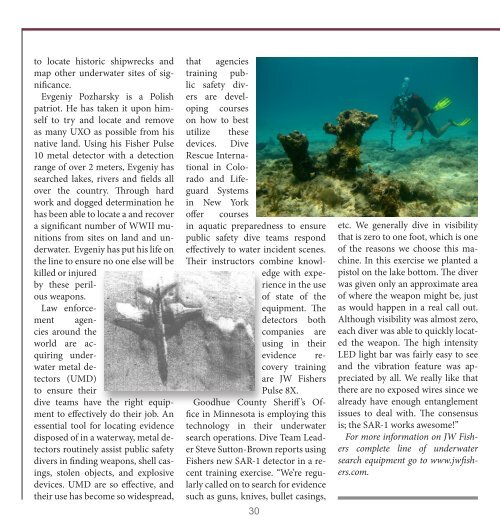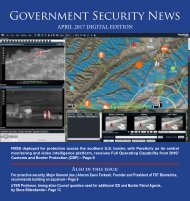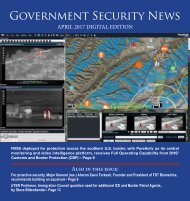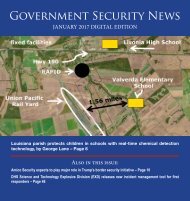GSN_Apr_FINAL+links
You also want an ePaper? Increase the reach of your titles
YUMPU automatically turns print PDFs into web optimized ePapers that Google loves.
to locate historic shipwrecks and<br />
map other underwater sites of significance.<br />
Evgeniy Pozharsky is a Polish<br />
patriot. He has taken it upon himself<br />
to try and locate and remove<br />
as many UXO as possible from his<br />
native land. Using his Fisher Pulse<br />
10 metal detector with a detection<br />
range of over 2 meters, Evgeniy has<br />
searched lakes, rivers and fields all<br />
over the country. Through hard<br />
work and dogged determination he<br />
has been able to locate a and recover<br />
a significant number of WWII munitions<br />
from sites on land and underwater.<br />
Evgeniy has put his life on<br />
the line to ensure no one else will be<br />
killed or injured<br />
by these perilous<br />
weapons.<br />
Law enforcement<br />
agencies<br />
around the<br />
world are acquiring<br />
underwater<br />
metal detectors<br />
(UMD)<br />
to ensure their<br />
dive teams have the right equipment<br />
to effectively do their job. An<br />
essential tool for locating evidence<br />
disposed of in a waterway, metal detectors<br />
routinely assist public safety<br />
divers in finding weapons, shell casings,<br />
stolen objects, and explosive<br />
devices. UMD are so effective, and<br />
their use has become so widespread,<br />
that agencies<br />
training public<br />
safety divers<br />
are developing<br />
courses<br />
on how to best<br />
utilize these<br />
devices. Dive<br />
Rescue International<br />
in Colorado<br />
and Lifeguard<br />
Systems<br />
in New York<br />
offer courses<br />
in aquatic preparedness to ensure<br />
public safety dive teams respond<br />
effectively to water incident scenes.<br />
Their instructors combine knowledge<br />
with experience<br />
in the use<br />
of state of the<br />
equipment. The<br />
detectors both<br />
companies are<br />
using in their<br />
evidence recovery<br />
training<br />
are JW Fishers<br />
Pulse 8X.<br />
Goodhue County Sheriff ’s Office<br />
in Minnesota is employing this<br />
technology in their underwater<br />
search operations. Dive Team Leader<br />
Steve Sutton-Brown reports using<br />
Fishers new SAR-1 detector in a recent<br />
training exercise. “We’re regularly<br />
called on to search for evidence<br />
such as guns, knives, bullet casings,<br />
etc. We generally dive in visibility<br />
that is zero to one foot, which is one<br />
of the reasons we choose this machine.<br />
In this exercise we planted a<br />
pistol on the lake bottom. The diver<br />
was given only an approximate area<br />
of where the weapon might be, just<br />
as would happen in a real call out.<br />
Although visibility was almost zero,<br />
each diver was able to quickly located<br />
the weapon. The high intensity<br />
LED light bar was fairly easy to see<br />
and the vibration feature was appreciated<br />
by all. We really like that<br />
there are no exposed wires since we<br />
already have enough entanglement<br />
issues to deal with. The consensus<br />
is; the SAR-1 works awesome!”<br />
For more information on JW Fishers<br />
complete line of underwater<br />
search equipment go to www.jwfishers.com.<br />
Raytheon wins $375M contract to<br />
modernize Air Force air and space<br />
operations centers<br />
Dave Wajsgras<br />
HAMPTON, VA <strong>Apr</strong>il 26, 2017 The<br />
U.S. Air Force Materiel Command<br />
has awarded Raytheon Company<br />
(NYSE: RTN) a contract with an initial<br />
value of up to $375 million over<br />
six years to sustain and modernize<br />
the Air and Space Operations<br />
Center Weapon System,<br />
or AOC WS. Under<br />
the contract, Raytheon will<br />
update the existing AOC WS<br />
baseline software and develop<br />
and deploy new software<br />
upgrades to improve air and<br />
space command and control<br />
operations.<br />
Air and Space Operations Centers<br />
provide a strategic capability for the<br />
U.S. Air Force with operators at 22<br />
global locations using the AOC WS<br />
to command and control aircraft<br />
through all of the Air Force’s critical<br />
missions.<br />
“Raytheon will use our unmatched<br />
cyber, automation and analytics expertise<br />
to modernize the Air Force’s<br />
weapons system, providing an advantage<br />
in everything from security to<br />
actionable insight in the digital battlespace,”<br />
said Dave Wajsgras, president<br />
of Raytheon Intelligence, Information<br />
and Services.<br />
“Raytheon’s innovative modernization<br />
through sustainment approach<br />
incrementally improves systems without<br />
interruption to critical missions,”<br />
said Todd Probert, vice president of<br />
Mission Support and Modernization<br />
at Raytheon IIS. “In addition, the use<br />
of software development best<br />
practices, such as Agile and<br />
DevOps, speeds up the delivery<br />
of these systems to the<br />
warfighter.”<br />
Raytheon is hiring for the<br />
new team based in Hampton,<br />
Virginia. Open positions include<br />
system architects, software<br />
developers, cyber engineers, IT<br />
help desk and more.<br />
About Raytheon<br />
Raytheon Company, with 2016 sales<br />
of $24 billion and 63,000 employees,<br />
is a technology and innovation leader<br />
specializing in defense, civil government<br />
and cybersecurity solutions.<br />
With a history of innovation spanning<br />
95 years, Raytheon provides state-ofthe-art<br />
electronics, mission systems<br />
integration, C5ITM products and<br />
services, sensing, effects, and mission<br />
support for customers in more than<br />
80 countries. Raytheon is headquartered<br />
in Waltham, Massachusetts.<br />
30 31<br />
For proactive security,<br />
build an aquarium<br />
Continued from page 6<br />
requires us to build an aquarium<br />
again – a fusion of technologies that<br />
provide speed and accuracy, and are<br />
simple for the end-user.<br />
The most secure and convenient<br />
biometric technology identity verification<br />
must use ‘the power of fusion.’<br />
By fusing face recognition,<br />
body behavior analytics – including<br />
height, gait and body type – and<br />
even voice recognition, we create a<br />
fusion that is highly accurate, and<br />
does not require a user to stop for<br />
identification. This fusion of sensors<br />
allows us to understand a person’s<br />
identity in real-time, with high accuracy<br />
and speed.<br />
Building this aquarium and utilizing<br />
a fusion of technologies for<br />
multimodal biometrics, we can<br />
make identification and secure access<br />
simple and secure. And most<br />
importantly, we can apply the power<br />
of fusion to prevent incidents before<br />
they happen.















